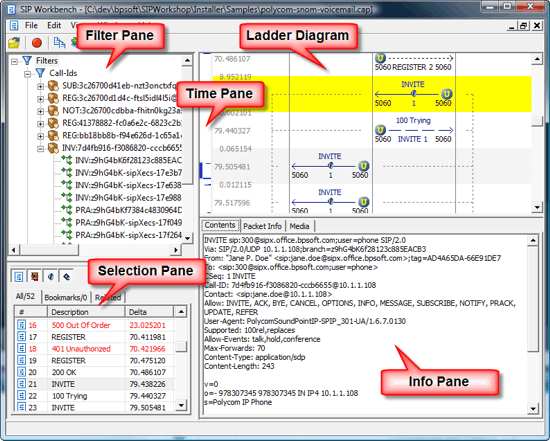
Visual DisplaySIP Workbench displays SIP, STUN, TURN and media start events in a color-coded ladder diagram. The diagram identifies the source and target IP addresses and ports, user-agent information, transport types (UDP or TCP), and summary information for the message. SIP markers include the method, response code/text, and sequence numbers; audio markers include the payload type; and STUN/TURN markers include the method type and mapped IP or relay addresses. When selecting a marker, the user is presented with transactional and session markers to help identify related messages. Time duration is provided for the session. CorrelationSIP Workbench maintains the relationship of SIP, STUN/TURN, and audio messages in the presentation of data. This feature allows users to ignore and filter uninteresting messages and and the decoded contents of SIP, STUN, and TURN messages. Network CaptureUsers can open libPCAP network captures created by tcpdump and WireShark. SIP Workbench can also capture packets directly for viewing. UI CustomizationSIP Workbench allows users to customize both how and which data are presented. Users can enable/disable all of the visual correlation features and modify the color coding used to display message categories (i.e., request, provisional response, error response, final response, error response, media markers, and related messages). |
FilteringUsers can filter by a specific SIP method, call-id, and to/from address. From a call-id, SIP Workbench enables further filtering by branch and individual transaction. A message selection window pane assists data filtering by providing a list of all messages available in the diagram and provides the ability to filter on SIP, STUN/TURN, and media categories. BookmarksAny marker can be added to a bookmark list for quick access. These bookmarked markers display the time relative to other bookmarked markers. Export and PrintingSIP Workbench provides the ability to print SIP diagrams and export diagrams to a text file. Text exports include an ASCII ladder diagram along with message details. MediaSIP Workbench provides summary information for audio and video streams. Users can review jitter and bandwidth graphs for each media stream and can extra media with or without RTP headers. RTCP reports are presented in a format that allows users to review information from sender reports, receiver reports, in addition to session description information. |